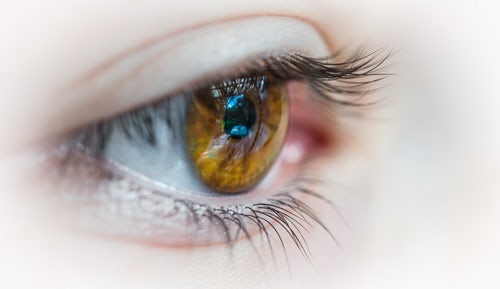What is Ptosis?
Ptosis consists of an excessive drooping of the upper eyelid. In principle, it can be broken down into the following:
· Reactionary Ptosis. It occurs in people from the age of 40
and is usually a process associated with the normal
ageing of the muscles and skin.
· Congenital Ptosis. When children are born with one
eyelid lower than the other.
Request more information without obligation
The main purpose of the eyelids is to protect the eyes. When we blink, our eyelids help to moisten our eyes and clear away any dust or other particles on their surface. Moreover, when our eyelids are closed, our eyes are protected against any possible traumatic injuries.
That is why, without of course forgetting the aesthetic aim of some procedures related to the eyelids, you should always pay them due care and attention for reasons of eye health.

Symptoms of Ptosis
In this case, instead of symptom, we talk about the form in which it presents itself: the drooping of the eyelid. At any rate, Ptosis is easier to detect when comparing the two eyelids while it can be more difficult when it occurs on both.
Its direct consequences, depending on the degree to which the eyelid droops and on whether its covers the eye to a greater or lesser extent, come in a range of forms: problems with vision, sensation of a reduced field of vision, pain and feeling of tiredness, tearfulness. In the case of children, they may tilt their heads backwards in an attempt to see under the eyelid and, at times, it may lead to Amblyopia (“lazy eye”).
Diagnosis and Treatment
In general, the solution is surgical. Following an examination during the consultation with the Ophthalmologist, several surgical options are available.
The eyelid has two muscles whose function is to lift it. You may opt for an external operation, through the skin, or an internal operation, through the conjunctiva (internal layer of the eyelid). At times, an upper blepharoplasty (removing excess skin) is performed on one of the two upper eyelids.
In most cases, a local anaesthetic is applied. It is injected into the skin or the conjunctiva depending on the muscle to which the procedure relates. It is also possible to use sedation.
After surgery, the eyelids may be inflamed during the first month, although this is most noticeable in the first week.
Although there is no contraindication for returning to work, if that is your desire, on the day following the operation, you are not advised to perform any physical exercise in the first week to ensure that exertion does not cause any eyelid bruising or harm the scar.
The post-surgical results are virtually immediate as the eyelid usually repositions itself in the first few weeks.
Frequently asked questions about Ptosis.
Will the scar be visible?
The scar by the external method, which is produced by taking advantage of the crease of the upper eyelid, is concealed when your eyes are open, which is why it is only visible when they are closed. Even over time, as it coincides with “wrinkles” on the skin of the eyelid, it is very difficult to distinguish. The scar produced by the internal method is not visible or perceptible.
What care do I require following treatment?
After the eyelid operation, you should avoid any great physical exertion. Sunglasses are useful for concealing the swelling to the eyelid and they prevent the scar from being exposed to solar radiation which may be detrimental to the development of the scar. Any bruising may be concealed with make-up.
Immediate treatment involves anti-inflammatories and a cold compress as well as artificial tears which will be recommended by the oculoplastic surgeon.
Can the treatment be repeated?
Yes, if there is asymmetry in the result
What are the most frequent complications?
After any surgery, a natural inflammatory process occurs in the body to scar the tissue affected by the procedure. Particularly on account of the thinness of the eyelid skin, temporary swelling usually occurs and it may last for at least one week. It is usually moderate and is treated with a cold compress and an ointment. Moreover, post-operative bruising is frequent and may last for one or more weeks; it can be concealed with make-up.
What about less frequent complications?
They are not very frequent. They include the difficulty to fully close your eyes, especially in the first few weeks, because the eyelid is higher than expected. You may occasionally be affected by asymmetry which requires further surgery (up to 20% of cases of ptosis require further surgery for a number of different reasons).
¿Y las complicaciones menos frecuentes?
Son muy poco frecuentes. Entre ellas cabe señalar la dificultad para cerrar bien los ojos, sobre todo las primeras semanas, porque el párpado está más alto de lo esperado. En ocasiones podemos encontrarnos asimetrías que precisen reintervenciones (hasta un 20% de las ptosis precisan reintervenciones por diferentes causas).

A team of the highest professional standards
Central Ocular boasts a highly qualified professional medical team which has vast experience in presbyopia operations. Your vision could not be in better hands.
Cutting-edge technology
Our technological capabilities are based on the most advanced equipment which allows us to provide our patients undergoing presbyopia procedures with the best possible guarantees.
The best facilities
The outstanding facilities at Central Ocular mean that presbyopia procedures are performed in optimum conditions of safety and comfort for the patient. We make you feel right at home.
Our patients recommend us
The best form of publicity is provided by our patients who have undergone the presbyopia procedure. I wish I’d had it done sooner! A source of great satisfaction for the whole of our medical team.


